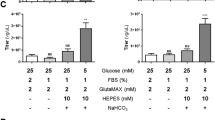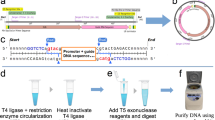Abstract
We have developed a novel DNA expression system, based on the Semliki Forest virus (SFV) replicon, which combines a wide choice of animal cell hosts, high efficiency and ease of use. DNA of interest is cloned into SFV plasmid vectors that serve as templates for in vitro synthesis of recombinant RNA. The RNA is transfected with virtually 100% efficiency into animal tissue culture cells by means of electroporation. Within the cell, the recombinant RNA drives its own replication and capping and leads to massive production of the heterologous protein while competing out the host protein synthesis. The expression system also includes an in vivo packaging procedure whereby recombinant RNA is packaged into infectious virus particles using cotransfection with packaging–deficient helper RNA molecules. The resulting high titer recombinant virus stock can be used to infect a wide range of animal cells with subsequent high expression of the heterologous gene product, but without expression of any structural proteins of the helper. The infected cells produce protein for up to 75 hours post infection after which the heterologous product can constitute as much as 25% of the total cell protein. The general utility of the system is demonstrated through the expression of human transferrin receptor, mouse dihydrofolate reductase, chick lysozyme and Escherichia coli β–galactosidase.
This is a preview of subscription content, access via your institution
Access options
Subscribe to this journal
Receive 12 print issues and online access
$209.00 per year
only $17.42 per issue
Buy this article
- Purchase on Springer Link
- Instant access to full article PDF
Prices may be subject to local taxes which are calculated during checkout
Similar content being viewed by others
References
Bishop, D.H.L. 1990. Gene expression using insect cells and viruses, p. 62–67. In: Current Opinion in Biotechnology. M. Rosenberg and B. Moss (Eds). Current Opinion Ltd., London.
Moss, B. 1990. Regulation of Vaccinia virus transcription. Ann. Rev. Biochem. 59: 661–688.
Moss, B., Elroy-Stein, O., Mizukami, T., Alexander, W.A. and Fuerst, T.R. 1990. New mammalian expression vectors. Nature 348 :91–92.
Garoff, H., Kondor-Koch, C. and Riedel, H. 1982. Structure and assembly of alphaviruses. Curr. Top. Microbiol. Immunol. 99: 1–50.
Simons, K. and Fuller, S. 1987. The budding of enveloped viruses: A paradigm for membrane sorting?, p. 139–150. In: Biological Organization: Macromolecular Interactions at High Resolution. R. K. Burnett and R. H. Vogel (Eds). Academic Press, New York.
Strauss, E.G. and Strauss, J.H. 1986. Structure and replication of the alphavirus genome, p. 35–90. In: The Togaviridae and Flaviviridae. S. S. Schlesinger and M.J. Schlesinger (Eds.). Plenum Press, New York.
Schlesinger, S.S. and Schlesinger, M.J. (Eds.). 1986. The Togaviridae and Flaviviridae, p. 453. Plenum Press, New York.
Xiong, C., Levis, R., Shen, P., Schlesinger, S., Rice, C.M. and Huang, H.V. 1989. Sindbis virus: An efficient, broad host range vector for gene expression in animal cells. Science 243: 1188–1191.
Wahlberg, J.M., Boere, W.A. and Garoff, H. 1989. The heterodimeric association between the membrane proteins of Semliki Forest virus changes its sensitivity to mildly acidic pH during virus maturation. J. Virol. 63: 4991–4997.
Garoff, H., Huylebroeck, D., Robinson, A., Tillman, U. and Liljeström, P. 1990. The signal sequence of the p62 protein of Semliki Forest virus is involved in initiation but not in completing chain translocation. J. Cell Biol. 111: 867–876.
Metsikkö, K. and Garoff, H. 1990. Oligomers of the cytoplasmic domain of the p62/E2 membrane protein of Semliki Forest virus bind to the nucleocapsid in vitro. J. Virol. 64: 4678–4683.
Liljeström, P. and Garoff, H. 1991. Internally located cleavable signal sequences direct the formation of Semliki Forest virus membrane proteins from a polyprotein precursor. J. Virol. 65: 147–154.
Lusa, S., Garoff, H. and Liljeström, P. 1991. Fate of the 6K membrane protein of Semliki Forest virus during virus assembly. Virology 185: 000–000.
Griffin, D.E. 1986. Alphavirus pathogenesis and immunity, p. 209–250. In The Togaviridae and Flaviviridae. S. S. Schlesinger and M. J. Schlesinger (Eds.). Plenum Press, New York.
Clark, H.F., Cohen, M.M. and Lunger, P.D. 1973. Comparative characterization of a C-type virus-producing cell line (VSW) and a virus-free cell line (VH2) from Vipera russelli. J. Natl. Cancer Inst. 51: 645–657.
Leake, C.J., Varma, M.G.R. and Pudney, M. 1977. Cytopathic effect and plaque formation by Arboviruses in a continuous cell line (XTC-2) from the toad Xenopus laevis. J. Gen. Virol. 35: 335–339.
Stollar, V. 1980. Defective interfering alphaviruses, p. 427–457. In: The Togaviruses. R. W. Schlesinger (Ed.). Academic Press, New York.
L'Héritier, P. 1977. About the infection of Drosophila female germ line cells by Sigma viruses. Ann. Microbiol. (Inst. Pasteur) 128A: 119–131.
Liljeström, P., Lusa, S., Huylebroeck, D. and Garoff, H. 1991. In vitro mutagenesis of a full-length cDNA clone of Semliki Forest virus: the 6,000-molecular-weight membrane protein modulates virus release. J. Virol. 65: 4107–4113.
Levis, R., Schlesinger, S. and Huang, H.V. 1990. Promoter for Sindbis virus RNA-dependent subgenomic RNA transcription. J. Virol. 64: 1726–1733.
Grakoui, A., Levis, R., Raju, R., Huang, H.V. and Rice, C.M. 1989. A cis-acting mutation in the Sindbis virus junction region which affects subgenomic RNA synthesis. J. Virol. 63: 5216–5227.
Tsiang, M., Weiss, B.G. and Schlesinger, S. 1988. Effects of 5′-terminal modifications on the biological activity of defective interfering RNAs of Sindbis virus. J. Virol. 62: 47–53.
Niesters, H.G.M. and Strauss, J.H. 1990. Mutagenesis of the conserved 51-nucleotide region of Sindbis virus. J. Virol. 64: 1639–1647.
Niesters, H.G. and Strauss, J.H. 1990. Defined mutations in the 5′ nontranslated sequence of Sindbis virus RNA. J. Virol. 64: 4162–4168.
Levis, R., Weiss, B.G., Tsiang, M., Huang, H. and Schlesinger, S. 1986. Deletion mapping of Sindbis virus DI RNAs derived from cDNAs defines the sequences essential for replication and packaging. Cell 44: 137–145.
Kuhn, R.J., Hong, Z. and Strauss, J.H. 1990. Mutagenesis of the 3′ nontranslated region of Sindbis virus RNA. J. Virol. 64: 1465–1476.
Weiss, B., Nitschko, H., Ghattas, I., Wright, R. and Schlesinger, S. 1989. Evidence for specificity in the encapsidation of Sindbis virus RNAs. J. Virol. 63: 5310–5318.
Weiss, B.G. and Schlesinger, S. 1991. Recombination between Sindbis virus RNAs. J. Virol. 65: 4017–4025.
Peränen, J., Takkinen, K., Kalkkinen, N. and Kääriäinen, L. 1988. Semliki Forest virus-specific non-structural protein nsP3 is a phospho-protein. J. Gen. Virol. 69: 2165–2178.
Boere, W.A.M., Harmsen, T., Vinje, J., Benaissa-Trouw, B.J., Kraaijeeveld, C.A. and Snippe, H. 1984. Identification of distinct antigenic determinants on Semliki Forest virus by using monoclonal antibodies with different antiviral activities. J. Virol. 52: 575–582.
Greiser-Wilke, I., Moennig, V., Kaaden, O.-R. and Figueiredo, L.T.M. 1989. Most alphaviruses share a conserved epitopic region on their nucleocapsid protein. J. Gen. Virol. 70: 743–748.
Kondor, K.C., Bravo, R., Fuller, S.D., Cutler, D. and Garoff, H. 1985. Exocytotic pathways exist to both the apical and the basolateral cell surface of the polarized epithelial cell MDCK. Cell 43: 297–306.
Zerial, M., Melançon, P., Schneider, C. and Garoff, H. 1986. The transmembrane segment of the human transferrin receptor functions as a signal peptide. EMBO J. 5: 1543–1550.
Krieg, P., Strachman, R., Wallis, E., Tabe, L. and Colman, A. 1984. Efficient expression of cloned complementary DNAs for secretory proteins after injection into Xenopus oocytes. J. Mol. Biol. 180: 615–643.
Casadaban, M.J., Martinez-Arias, A., Shapira, S.K. and Chou, J. 1983. β-galactosidase gene fusions for analyzing gene expression in Escherichia coli and yeast. Meth. Enzymol. 65: 293–308.
Silhavy, T.J., Berman, M.L. and Enquist, L.W. 1984. Experiments with Gene Fusions, p. 303. Cold Spring Harbor Laboratory Press, New York.
Kozak, M. 1989. The scanning model for translation: an update. J. Cell Biol. 108: 229–241.
Author information
Authors and Affiliations
Rights and permissions
About this article
Cite this article
Liljeström, P., Garoff, H. A New Generation of Animal Cell Expression Vectors Based on the Semliki Forest Virus Replicon. Nat Biotechnol 9, 1356–1361 (1991). https://doi.org/10.1038/nbt1291-1356
Received:
Accepted:
Issue Date:
DOI: https://doi.org/10.1038/nbt1291-1356
This article is cited by
-
Self-replicating vehicles based on negative strand RNA viruses
Cancer Gene Therapy (2023)
-
Next generation self-replicating RNA vectors for vaccines and immunotherapies
Cancer Gene Therapy (2023)
-
Cancer vaccine strategies using self-replicating RNA viral platforms
Cancer Gene Therapy (2023)
-
DNA-launched RNA replicon vaccines induce potent anti-SARS-CoV-2 immune responses in mice
Scientific Reports (2021)
-
Facile method for delivering chikungunya viral replicons into mosquitoes and mammalian cells
Scientific Reports (2021)



